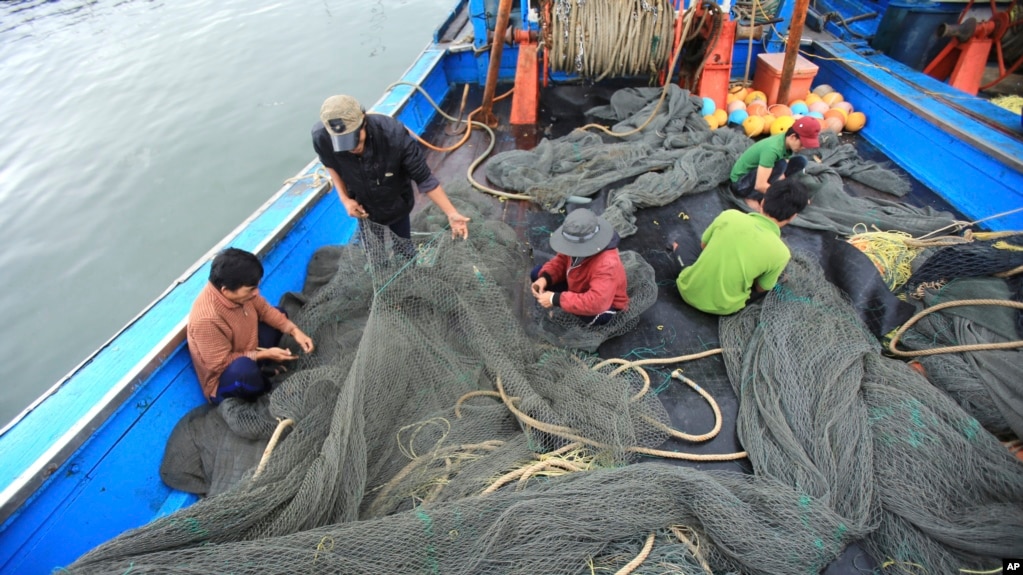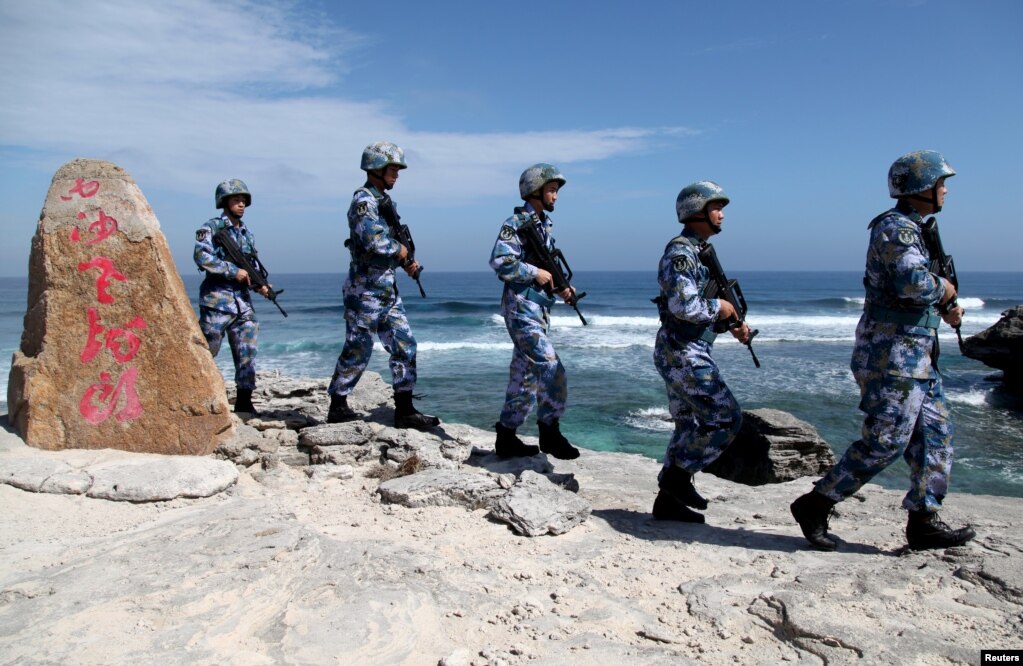
FILE – Vietnamese fishermen fix nets on their boat as while docked at Tho Quang port, Danang, Vietnam, after a fishing trip in the South China Sea, March 27, 2016.
Ho Chi Minh City —
Vietnam is taking a more outspoken and transparent approach in response to China’s recent detention of Vietnamese fishermen in the South China Sea, analysts tell VOA.
Hanoi is also moving forward with the construction of a new airstrip on a reef in its exclusive economic zone to further assert its sovereignty and challenge Beijing’s claims.
Late last week, deputy spokesperson for Vietnam\’s foreign affairs ministry Doan Khac Viet called on China to release the fishermen who were captured with their fishing vessels in waters surrounding the Paracel Islands. Vietnam did not specify when or how many fishermen were detained.
"Vietnam resolutely opposes China’s actions, and requests China to fully respect Vietnam’s rights over the Paracel Islands, release all illegally detained Vietnamese fishermen and vessels, compensate for damage, and stop and not repeat the harassment and illegal capture of Vietnamese vessels and fishermen," Viet said during a news conference late last week on October 31.
Viet did not say when or how many fishermen have been detained. However, Radio Free Asia quoted a Chinese think tank saying this week that Vietnamese fishermen have been in Chinese detention in the Paracel archipelago for more than six months.
The Beijing-based South China Sea Probing Initiative, or SCSPI, said on the social media platform X that the fishermen “were detained in April and May” for illegal fishing activities in the waters around the Paracels, RFA reported.
"There are always Vietnamese fishermen in waters that are sensitive," Raymond Powell, a fellow at Stanford University\’s Gordian Knot Center for National Security Innovation, told VOA on Monday. "We don\’t know really how many have been detained because Vietnam is not the most transparent of administrations."
China has disputed Vietnam’s description of what happened.
Asked about the incident last Friday, Chinese Foreign Ministry spokesperson Lin Jian said, “China urges the Vietnamese side to do more to ask their fishermen to stop being engaged in illegal activities in waters under China’s jurisdiction.”
Known as Hoang Sa in Vietnamese, the Paracels have been under Chinese control since it occupied the islands in a violent conflict with Vietnam in 1974. China claims that most of the South China Sea is part of its territory, despite an international ruling to the contrary.

FILE – Soldiers of China's People's Liberation Army (PLA) Navy patrol at Woody Island, in the Paracel Archipelago, which is known in China as the Xisha Islands, Jan. 29, 2016.
Nguyen Khac Giang, visiting fellow at the ISEAS-Yusof Ishak Institute, said China\’s harassment of Vietnamese fishermen around the Paracels is common but Hanoi\’s recent response shows a new approach from Hanoi.
“I think this move is inspired by the ‘transparency initiative’ by the Philippines,” Giang told VOA on a November 5 call, referring to how the Philippines government under President Ferdinand Marcos Jr. has been exposing China\’s aggression in the South China Sea.
Hanoi must manage a delicate balancing act, squeezed between its powerful neighbor, Western allies, and showing its population, it is not kowtowing to China, Giang added.
By taking a more transparent approach similar to the Philippines, Vietnam is allowing “anyone who wants to know about the current situation in the South China Sea dispute to judge for themselves who is right and who is wrong,” Giang said. “Vietnam has to play the game. Having this kind of transparency initiative is a part of the game.”
Clashing at sea
Vietnam hasn\’t been as outspoken regarding China\’s actions in the South China Sea since 2014, when China deployed an oil rig near the Paracel Islands, Giang said. The move led to anti-China protests in Vietnam and a monthslong standoff between Chinese and Vietnamese vessels.
Giang noticed Hanoi again taking a more public approach in early October when local media reported a “brutal attack on fishermen from Quang Ngai province.”
According to local outlet VnExpress, two Chinese ships surrounded a Vietnamese fishing vessel on September 29. About 40 people from the Chinese ships boarded the Vietnamese vessel and beat the fishermen with metal rods, breaking bones and leaving one man unconscious.
The Vietnamese fishermen said their gear and fish catch weighing four tons were also stolen before they were allowed to return to land.
A fisherman in his 30s from coastal Binh Thuan province described Chinese fishing vessels in that area are “armed and aggressive.”
“The Chinese don’t seem afraid of us,” he told VOA in Vietnamese on November 4, asking to withhold his name due to the sensitivity of the topic. “In fact, they behave as if the area belongs to their country.”
The fishermen in Binh Thuan said one of his friends has "been threatened by a Chinese boat" and another has had their vessel "attacked" by a Chinese ship and their equipment stolen.
On October 2, foreign ministry spokesperson Pham Thu Hang stated, “Vietnam is extremely concerned, indignant and resolutely protests the brutal treatment by Chinese law enforcement forces of Vietnamese fishermen."
Powell of Stanford University, said that Hanoi is generally more tight-lipped when it comes to China\’s attacks on Vietnamese fishermen, but the recent beatings may have been impossible for Hanoi to ignore.
“They may just have reached their limit,” Powell told VOA over the phone on November 4. “The injury to those fishermen was so bad that it really couldn\’t be contained.”
New airstrip
In addition to protesting China\’s treatment of Vietnamese fishermen, Hanoi has been building up artificial islands in the South China Sea. Satellite imagery shows its most recent effort is building an airstrip on Barque Canada reef, a rock near the within Vietnam\’s exclusive economic zone.

FILE – An aerial view of Southwest Cay, also known as Pugad Island, controlled by Vietnam and part of the Spratly Islands in the disputed South China Sea, April 21, 2017.
Collin Koh Swee Lean, senior fellow at Singapore\’s Institute of Defense and Strategic Studies, told VOA on November 5 that the airstrip could be as long as 3,000 meters (1.86 miles). He noted that the airstrip is likely to be used for temporary stopovers, refueling aircraft, and potentially to store munitions and rearm during a crisis.
The airstrip “will allow the Vietnamese to have a much more persistent presence over the South China Sea,” Koh said.
Powell said that Vietnam has used China\’s preoccupation with the Philippines in recent years to focus on island-building. “China hasn\’t said very much about [Vietnam\’s island-building] perhaps because they\’ve been so preoccupied with the Philippines,” Powell said. “Vietnam is literally strengthening their military outposts.”
Growing its military strength at sea is considered crucial for Hanoi as China\’s influence grows over neighboring Cambodia and Laos. Hanoi may also be concerned about the Philippines swinging to a more China-friendly leadership in its 2028 election.
“The Vietnamese realized that there is so much Chinese build-up in the neighborhood,” he said. “Vietnam is trying to counter that with its own build-up.”
-

VOA News
The Voice of America provides news and information in more than 40 languages to an estimated weekly audience of over 326 million people. Stories with the VOA News byline are the work of multiple VOA journalists and may contain information from wire service reports.
Subscribe
By:VOA